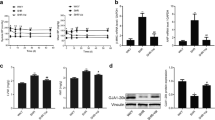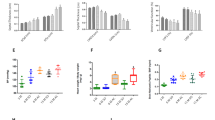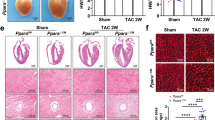Abstract
Background
Mitochondrial coupling factor 6 (CF6) is a constriction factor in cardiac hypertrophy, whose mechanisms are not fully understood.
Materials and methods
Here, we established cardiac hypertrophy models for feeding spontaneously hypertensive rats (SHRs) aged 10, 20, and 30 weeks. Hemodynamic monitoring was performed during the feeding program to ensure the success of the model.
Results
Cardiac hypertrophy, but not fibrosis, occurred in the 10-, 20-, and 30-week-old SHRs. No significant changes in CF6 gene expression were detected by RT-PCR in any of the SHR groups as compared with the control groups (p > 0.05). ELISA assessment showed that the CF6 protein level in the 20- and 30-week-old SHRs with cardiac hypertrophy was significantlyincreased (vs. control, p < 0.05).
Conclusion
CF6 protein was upregulated in cardiac hypertrophy induced by hypertension; further mechanisms involved in this process should be investigated.
Zusammenfassung
Hintergrund
„Mitochondrial coupling factor 6“ (CF6) ist ein Konstriktionsfaktor bei kardialer Hypertrophie, dessen Wirkweise noch nicht vollständig bekannt ist.
Methoden
In der vorliegenden Arbeit entwickelten die Autoren Modelle kardialer Hypertrophie mit Fütterung spontan hypertensiver Ratten (SHR) im Alter von 10, 20 und 30 Wochen. Das hämodynamische Monitoring erfolgte im Rahmen des Fütterungsschemas, um den Erfolg des Modells zu sichern.
Ergebnisse
Es trat eine kardiale Hypertrophie, nicht aber eine Fibrose bei den 10, 20 und 30 Wochen alten SHR auf. Signifikante Veränderungen der CF6-Gen-Expression wurden mittels RT-PCR bei den 10, 20 und 30 Wochen alten SHR im Vergleich zu den jeweiligen Kontrollgruppen nicht festgestellt (p > 0,05). Die Untersuchung mittels ELISA ergab, dass der CF6-Protein-Wert bei den 20 und 30 Wochen alten SHR mit kardialer Hypertrophie (gegenüber den Kontrollen; p < 0,05) signifikant erhöht war.
Schlussfolgerung
Das CF6-Protein war bei durch Hypertonie induzierter kardialer Hypertrophie hochreguliert; weitere Abläufe, die an diesem Vorgang beteiligt sind, sollten noch untersucht werden.





Similar content being viewed by others
References
Osanai T, Tanaka M, Kamada T et al (2001) Mitochondrial coupling factor 6 as a potent endogenous vasoconstrictor. J Clin Invest 108:1023–1030
Osanai T, Saitoh M, Sasaki S et al (2003) Effect of shear stress on asymmetric dimethylarginine release from vascular endothelial cells. Hypertension 42:985–990
Izumiyama K, Osanai T, Sagara S et al (2012) Estrogen attenuates coupling factor 6-induced salt-sensitive hypertension and cardiac systolic dysfunction in mice. Hypertens Res 35:539–546
Sukekawa T, Osanai T, Nishizaki F et al (2013) Coupling factor 6 enhances the spontaneous microaggregation of platelets by decreasing cytosolic cAMP irrespective of antiplatelet therapy. Hypertens Res 36:520–527
Sagara S, Osanai T, Itoh T et al (2012) Overexpression of coupling factor 6 attenuates exercise-induced physiological cardiac hypertrophy by inhibiting PI3K/Akt signaling in mice. J Hypertens 30:778–786
Osanai T, Tanaka M, Magota K et al (2012) Coupling factor 6-induced activation of ecto-F1F(o) complex induces insulin resistance, mild glucose intolerance and elevated blood pressure in mice. Diabetologia 55:520–529
Osanai T, Fujiwara N, Sasaki S et al (2010) Novel pro-atherogenic molecule coupling factor 6 is elevated in patients with stroke: a possible linkage to homocysteine. Ann Med 42:79–86
Osanai T, Magota K, Okumura K et al (2009) Coupling factor 6 as a novel vasoactive and proatherogenic peptide in vascular endothelial cells. Naunyn Schmiedebergs Arch Pharmacol 380:205–214
Osanai T, Tomita H, Yamada M et al (2009) Coupling factor 6-induced prostacyclin inhibition is enhanced in vascular smooth muscle cells from spontaneously hypertensive rats. J Hypertens 27:1823–1828
Echizen T, Osanai T, Ashitate T et al (2009) Upregulation of soluble vascular endothelial growth factor receptor type 1 by endogenous prostacyclin inhibitor coupling factor 6 in vascular endothelial cells: a role of acidosis-induced c-Src activation. Hypertens Res 32:182–187
Bueno OF, Molkentin JD (2002) Involvement of extracellular signal-regulated kinases 1/2 in cardiac hypertrophy and cell death. Circ Res 91:776–781
Sadoshima J, Izumo S (1993) Molecular characterization of angiotensin-II-induced hypertrophy of cardiac myocytes and hyperplasia of cardiac fibroblasts-critical role of the at (1) receptor subtype. Circ Res 73:413–423
Drazner MH (2011) The progression of hypertensive heart disease. Circulation 123:327–334
Nadruz W (2015) Myocardial remodeling in hypertension. J Hum Hypertens (published 2014/05/08.) doi:10.1038/jhh.2014.36
Cohn JN, Ferrari R, Sharpe N et al (2000) Cardiac remodeling—concepts and clinical implications: a consensus paper from an international forum on cardiac remodeling. Behalf of an International Forum on Cardiac Remodeling. J Am Coll Cardiol 35:569–582
Mann DL (2002) Inflammatory mediators and the failing heart: past, present, and the foreseeable future. Circ Res 91:988–998
Jia L, Li Y, Xiao C et al (2012) Angiotensin II induces inflammation leading to cardiac remodeling. Front Biosci (Landmark Ed) 17:221–231
Shahbaz AU, Sun Y, Bhattacharya SK et al (2010) Fibrosis in hypertensive heart disease: molecular pathways and cardioprotective strategies. J Hypertens 28:25–32
Osanai T, Matsumura H, Kikuchi T et al (1990) Changes in vascular wall production of prostacyclin and thromboxane A2 in spontaneously hypertensive rats during maturation and the concomitant development of hypertension. Jpn Circ J 54:507–514
Falardeau P, Robillard M, Martineau A (1985) Urinary levels of 2, 3-dinor-6-oxo-PGF1 alpha: a reliable index of the production of PGI2 in the spontaneously hypertensive rat. Prostaglandins 29:621–628
Osanai T, Kamada T, Fujiwara N et al (1998) A novel inhibitory effect on prostacyclin synthesis of coupling factor 6 extracted from the heart of spontaneously hypertensive rats. J Biol Chem 273:31778–31783
Ando J, Tsuboi H, Korenaga R et al (1996) Differential display and cloning of shear stress-responsive messenger RNAs in human endothelial cells. Biochem Biophys Res Commun 225:347–351
Osanai T, Okada S, Sirato K et al (2001) Mitochondrial coupling factor 6 is present on the surface of human vascular endothelial cells and is released by shear stress. Circulation 104:3132–3136
Osanai T, Tomita H, Kushibiki M et al (2009) Coupling factor 6 enhances Src-mediated responsiveness to angiotensin II in resistance arterioles and cells. Cardiovasc Res 81:780–787
Sen S, Tarazi RC, Khairallah PA et al (1974) Cardiac hypertrophy in spontaneously hypertensive rats. Circ Res 35:775–781
Acknowledgments
The project was supported by the National Natural Science Foundation of China (Grant No. 81200175), Qingdao Science and Technology Support Program [2011-2-3-2-(14)-nsh], and China Postdoctoral Science Foundation (2014M551872).
Author information
Authors and Affiliations
Corresponding authors
Ethics declarations
Conflict of interest
T. He, A. Guan, Y. Shi, Z. Ge, and H. Dai state that there are no conflicts of interest.
All national guidelines on the care and use of laboratory animals have been followed and the necessary approval was obtained from the relevant authorities.
Additional information
T. He and A. Guan contributed equally to this work.
Rights and permissions
About this article
Cite this article
He, T., Guan, A., Shi, Y. et al. Mitochondrial coupling factor 6 upregulation in hypertension-induced cardiac hypertrophy. Herz 40, 783–787 (2015). https://doi.org/10.1007/s00059-015-4301-8
Received:
Revised:
Accepted:
Published:
Issue Date:
DOI: https://doi.org/10.1007/s00059-015-4301-8
Keywords
- Mitochondrial coupling factor 6, CF6
- Hypertension
- Cardiac hypertrophy
- Fibrosis
- Spontaneously hypertensive rat model




